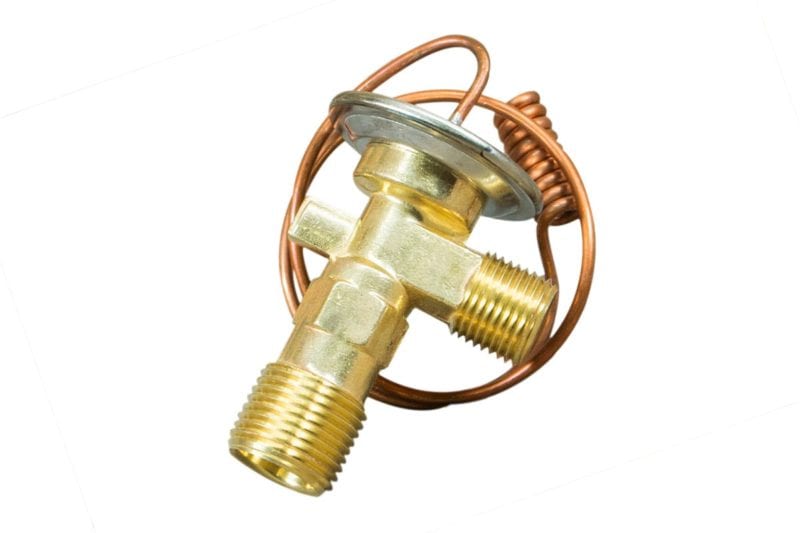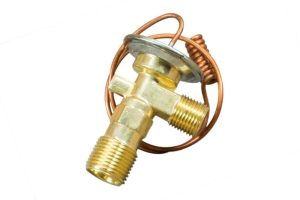Have you ever wondered how your air conditioner creates cool air on hot summer days? The secret lies in a small but crucial component called the expansion valve. This tiny device controls refrigerant flow in your cooling systems with remarkable precision. Without it, your air conditioner wouldn’t function properly. The expansion valve is a critical focus point in these systems. Understanding how these valves work can save you money and prevent system failures.
Today, I’ll explain expansion valves and why they matter for cooling systems. You’ll also learn about the different types and their specific applications in various equipment. This knowledge will help you make informed decisions about your HVAC equipment.
What Is an Expansion Valve?

An expansion valve is a throttling device that controls refrigerant flow in refrigeration and air conditioning systems. It sits between the condenser and evaporator in your cooling system’s refrigeration cycle and reduces the pressure of the high-pressure liquid refrigerant coming from the condenser.
This pressure reduction causes the refrigerant to expand and partially evaporate. The refrigerant temperature drops significantly during this process, creating the cooling effect. Think of it as a gatekeeper controlling how much refrigerant enters the evaporator.
Most expansion valves respond automatically to temperature and pressure changes. They adjust the refrigerant flow rate based on the cooling demand in real time. This self-regulating capability ensures optimal system performance under varying conditions.
What Is the Purpose of an Expansion Valve in HVAC&R?
The primary function of an expansion valve is to control refrigerant flow into the evaporator. It maintains the proper pressure difference between the high and low sides of the system. This pressure differential is essential for the refrigeration cycle to work efficiently.
When refrigerant passes through the valve, it transforms from a high-pressure liquid to a low-pressure mixture. This transformation allows the refrigerant to absorb heat in the evaporator effectively, and the valve ensures the evaporator receives precisely the right amount of refrigerant.
Another purpose is maintaining the appropriate superheat level at the evaporator outlet. Superheat refers to the temperature above the refrigerant’s boiling point. Proper superheat ensures that all refrigerant evaporates before reaching the compressor.
Expansion valves also protect the compressor from liquid refrigerant damage. They prevent liquid refrigerant from entering the compressor, which could cause mechanical failure. This protection extends the life of your expensive compressor component.
In my experience working with commercial buildings, properly sized expansion valves can reduce energy consumption by up to 15%. The right valve matches the system’s capacity and operating conditions perfectly. This optimization directly translates to lower energy bills over time.
What Types of Expansion Valves Are There?
Thermostatic Expansion Valves (TXVs)

Thermostatic expansion valves are the most common type used in refrigeration systems today. They regulate refrigerant flow based on the temperature at the evaporator outlet. A sensing bulb attached to the evaporator outlet pipe controls the valve operation.
The sensing bulb contains a charge fluid that expands or contracts with temperature changes. This fluid movement opens or closes the valve to maintain constant superheat. TXVs provide precise control across a wide range of operating conditions.
Different bulb charges are available for various applications and refrigerants. These include vapor, liquid, cross, and universal charges. Each charge type offers different performance characteristics for specific applications.
External equalizer TXVs are designed for systems with pressure drops across the evaporator. They take pressure readings from both sides of the evaporator. This design provides more accurate control in larger or more complex systems.
Automatic Expansion Valves (AEVs)
Automatic expansion valves maintain constant pressure in the evaporator regardless of load conditions. They operate based on the balance between evaporator pressure and spring pressure. These valves are simpler in design than TXVs but offer less precise control.
AEVs work well in systems with relatively constant loads like household refrigerators. They’re less expensive than TXVs and require minimal maintenance. However, they don’t adjust well to varying load conditions.
The valve opens when evaporator pressure falls below the spring setting. It closes when the pressure rises above this setting. This simple mechanism makes AEVs reliable in stable operating environments.
Electronic Expansion Valves (EEVs)
Electronic expansion valves represent the cutting edge of refrigerant flow control technology. They use electronic controllers and stepper motors for precise positioning. EEVs offer superior control compared to mechanical valve alternatives.
These valves receive input from multiple sensors throughout the system. They can monitor pressures, temperatures, and even compressor load. This comprehensive data allows for optimized refrigerant flow under all conditions.
EEVs can adjust quickly to changing conditions for maximum efficiency. They’re ideal for systems that experience frequent load variations. Many modern variable refrigerant flow systems rely on EEVs for their operation.
The main drawback of EEVs is their higher cost and complexity. They require electronic controllers and sensors to function correctly. However, their energy savings often justify the initial investment.
Capillary Tube Expansion Valves
Capillary tubes are the simplest type of expansion device used in refrigeration systems. They consist of small-diameter tubes that create resistance to refrigerant flow. This resistance causes the necessary pressure drop for the refrigeration cycle.
These tubes work through their fixed length and diameter. They’re nonadjustable and have no moving parts. This simplicity makes them extremely reliable and inexpensive.
Capillary tubes are common in small refrigeration systems like household refrigerators. They work best in systems with consistent loads and operating conditions. Their fixed nature means they cannot adapt to changing conditions.
Which Expansion Valve Should You Use?
Expansion Valve for HVAC
Thermostic expansion valves (TXVs) are generally the best for residential and light commercial HVAC systems. They provide reasonable control while remaining cost-effective, and they adapt well to the varying loads typical in HVAC applications.
Electronic expansion valves (EEVs) might benefit larger commercial HVAC systems. These systems often experience wide load variations throughout the day. EEVs can optimize performance across these changing conditions for better efficiency.
Proper valve sizing is critical for optimal HVAC system performance. An undersized valve will restrict refrigerant flow and reduce capacity, while an oversized valve might allow too much refrigerant into the evaporator.
Expansion Valve for Water Heater Unit & Heat Pump
Heat pumps typically use thermostatic expansion valves with external equalizers. These valves can handle the reversing operation required in heat pump systems. They maintain proper superheat in both heating and cooling modes.
A heat pump’s expansion valve must accommodate indoor and outdoor coil functions and be compatible with the system’s refrigerant type. Most modern heat pumps use R-410A or newer refrigerants.
Valve selection should consider the higher operating temperatures for water heater heat pump units. Special bulb charges may be necessary for optimal performance. Consult manufacturer specifications for the best compatibility.
Expansion Valve for Refrigerator Freezer
Household refrigerator-freezers typically use capillary tubes as expansion devices. Their consistent operating conditions make fixed expansion devices suitable. Capillary tubes offer reliability and low cost for these applications.
Commercial refrigeration units often require thermostatic expansion valves (TXVs). These systems may experience more variable loads than residential units, and TXVs provide better control for maintaining proper temperatures.
The proper installation of the expansion device is crucial in refrigeration systems. Incorrect installation can lead to performance issues and energy waste. Always follow manufacturer guidelines for best results.
Thermal Expansion Valve for Transportation Refrigeration

Transportation refrigeration systems operate under demanding and variable conditions. They require robust expansion valves that can handle vibration and temperature extremes. Special TXVs designed for mobile applications work best here.
These valves must maintain precise control despite constant movement and jarring. They should be resistant to damage from road conditions. Durability is as important as control accuracy in these applications.
Electronic expansion valves are becoming more common in newer transport refrigeration units. They offer superior control and can be integrated with computerized monitoring systems. This technology helps maintain cargo at precise temperatures.
Thermal Expansion Valve for Rail Transportation
Rail refrigeration systems face unique challenges requiring specialized expansion valves. They must withstand prolonged vibration and extreme temperature variations. Heavy-duty TXVs or EEVs are typically used in these applications.
Reliability is paramount in rail transportation refrigeration systems. Valve failure could result in significant product loss during long hauls. Redundant systems are sometimes employed for critical cargo.
Professional certifications establish stringent criteria for shops to follow. The program validates technician education and equipment requirements at facilities. The facilities offer extended warranty terms to their clients. The certification comes with assurance about the quality of repair work.
Conclusion
Because of diminished value, your vehicle’s value decreases after an accident. Knowledge about this concept helps defend your monetary interests. Car owners who seek professional repairs from certified facilities will minimize the depreciation of their vehicle value. Documentation ensures insurance processing of remaining financial losses.
Perform prompt actions after an accident to maintain your asset’s worth. Select your vehicle maintenance facility via consideration of their official certifications. You should maintain detailed documentation for all repair work and appraisal processes. You should submit diminished value claims based on appropriate circumstances. The mentioned strategies work to sustain your vehicle’s monetary worth following collisions.
A vehicle accident creates financial problems that extend past repair expenses alone. Your investment benefits from proactive measures regarding diminished value. Any combination of high-quality maintenance work with documentation creates major value changes. Your driving vehicle stands as a valuable financial resource that needs sufficient protection.
Also Read: Why Causes a Car to Overheat at Idle?
FAQs
Common signs include inconsistent cooling, frost on refrigerant lines, and unusual compressor cycling.
They typically last 10-15 years but should be inspected annually for optimal performance.
This requires specialized tools and refrigerant handling certification, so professional installation is recommended.
No, some small systems use capillary tubes or other expansion devices instead.
A properly functioning valve ensures optimal refrigerant flow, reducing compressor workload and energy consumption.




